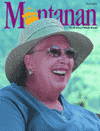
Fall 2001
CONTENTS Leaving Life in the Parking Lot
Where is the Parking Lot?
Fighting the World's Fight
Diva in Her Own Right
AROUND THE OVAL
LETTERS TO THE EDITOR
BOOKS
SPORTS
CLASS NOTES
ALUMNI NOTES
Contact Us
About the Montanan
PAST ISSUES
Books by Joyce H. Brusin
Montana is blessed, and cursed, with an interesting history. Among its mixed blessings are the abundant natural resources that have made it a battleground for conflicting interests. This highly readable book, tells how the people in a community, and then an entire valley, sought to make the industries that provided their livelihoods accountable for the environmental havoc that also sickened them. William L. Lang, director of the Center for Columbia River History at the Washington State Historical Society, provides an introduction that places the late Donald MacMillan’s work among the ever-revising histories of Butte and mining in Montana. While MacMillan’s work was “clearly influenced by the anti-colonialist and anti-corporatist tradition that drew a hard line between malefactors and victims in Montana’s political and social history,” writes Lang, he “edged toward a broader viewpoint on the relationships between industry, government, and political interest groups.” Other American mining communities experienced poor air quality at the turn of the century, but residents of Butte suffered disproportionately because of the sheer number of operations concentrated there. Smoke created winter inversions so bad that descriptions of them defy belief. William Hutchinson was an enterprising inventor who came to Butte promising deliverance from the misery. “His first day at work was not an auspicious one,” writes MacMillan. “He had instructed his assistants to be on the job ... before dawn. They had dutifully left their hotel at six that morning but had gotten lost in the smoke and ended up wandering about the southern part of town until noon, when a wind lifted the smoke. ‘Old Hutch’ himself fared little better. He had awakened early enough, but it was so dark from the smoke he didn’t know it was morning yet and overslept...” For the next three decades citizens tried everything from outright rebellion, to lawsuits, to personal audiences with the President to halt the constant release of pollutants into the air they breathed and the soil on which their stock grazed. The story of their suffering, as well as their stalwart efforts to confront the source of it, is at once disheartening and fascinating.
William Byrd II read voraciously — everything from sermons, to medical texts, to an immensely popular sexual handbook of the day. Passages and ideas from all of these found their way into his commonplace book. “The use of commonplace books was predicated on the idea that gathering and manipulating extracts of writings by or about wise men could help produce an eloquent, wise, and moral human being,” write the editors of this book, which provides revealing glimpses into the private life of one of America’s most influential colonialists. The editors provide a context for the commonplace book, then draw from other published manuscripts to examine the book in the context of Byrd’s life and time in history.
Virginia colonist Edward Waterhouse wrote home to Britain that “cows grew bigger in Virginia, horses were more beautiful and courageous, and deer were so fertile that does dropped three fawns at a time.” Seeking to improve upon this idealized landscape, Americans imported many species now among the most familiar to us — the honeybee, brown trout, starling, ringnecked pheasant and domesticated rock dove, which evolved into the urban pigeon. Long ago these immigrants blended into their adopted landscape, altered it, and became a part of its creation story. Kim Todd brings this story to us in measured and vivid accounts of the origins, journey and eventual fate of some of the exotic plants and animals introduced to new American habitats.
E.B. Webster, a newspaperman and president of a mountaineering club, engineered the journey of hardy mountain goats from their homes high in the Selkirks of Canada, across the Strait of Juan de Fuca to the spectacular Olympic Peninsula of Washington. Todd’s description of the peninsula captivates the reader: “The landscape, bound by the ocean, the strait, and the sound, turned in on itself with nowhere else to go. The brooding introspection bred a maze of creeks, summits, and valleys, endlessly familiar and endlessly surprising.” In the absence of natural predators, the goats clambered onto crags and mountainsides oddly suited to them and appeased their voracious appetites with almost anything that grew there, including alpine wildflowers found nowhere else on earth. If Webster could hike today through the valleys and ridges he loved so much, what would he think of his efforts to make them known to the rest of the world, wonders Todd? “Would he despair over the bare patches where the goats take their dirt baths? The remnants of overgrazed Flett’s violet? Or would he instead be distracted by the oil tankers gliding through the strait or the clear-cuts that run straight up to the park boundary? Which would spark more regret, his desire to bring mountain goats to the Olympics or his desire to attract people?” Such tempered musings are found throughout these richly researched accounts, which garnered the Pen/Jerard Award in 2000. Todd’s love for language and for science will captivate appreciative readers and curious naturalists in equal measure.

AROUND THE OVAL | SPORTS | CLASS NOTES | ALUMNI NOTES
|